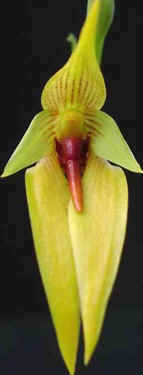Bulbophyllum Pg1
More
than 2000 species has been recognised in this large genus,
out of which a great majority is from Malesia region (more than 70%).
Visitors of highland cloud forests in Malesia will always find
some tiny species overwhelming the trunks of the trees and looking quite unlike
orchids to untrained eye, unless when they bloom. Many new ones are
continually being described from hot spots like PNG and
Borneo
which has 500 and 200 species at last count. Most species has a long creeping rhizome bearing pseudobulbs with 1 leaf
attached. There are many exceptions of course. Flowers may be solitary or in
clusters and range from very small (about 1mm) to more than 20cm tip-to tip (B.
echinolabium). Size -wise, there
are minute species to giants over a metre long in leaf span (B. fletcherianum and aff). Fragrant bloom
are exceptions rather than the rule as many are flies pollinated.
Bulbophyllums
used to be neglected by growers except for the usual favourites like the widely
available B. lobbi group. Apparently, the genus is now becoming popular, as
evidenced by their appearance in many commercial sales lists. There are many
weirdos in this group, like the giant B fletcherianum that has long leaves like
rabbit ears over a metre in length (not to mention its meat-coloured flowers
that smells like dead fish), B. anitum with its curiously flattened bulbs
hugging the tree, spectacular bloom of B. echinolabium that looks like a giant
star fish drifting in the woods, B. beccarii - another Borneo giant that curls
round giant tree trunks, trapping debris with its cup-like leaves, B bifordense
which has flower like a helmet with ears.
|

|
B.
carunculatum was described by Dr L. Garay, F. Hamer and E. Siegerist in
1995 from a plant originating in the Philippines. It has since been found
in Sulawesi and probably some nearby islands. Its growing habit is very
similar to the species below but the lip is rough and dark coloured. The
flower is also of a brighter tone.
|
|

|
Bulbophyllum
amplebracteatum
A large leave species from
Sulawesi. The flower is borned singly but
continuously on a rachis. This is closely related to the B. carunculatum
but has a bright red glabrous lip as shown.
Many thanks to Miss Levy and
Dr L. Garay in helping to ID this plant.
(I had forced the lip on top
of the sepal for identification purpose - its not the natural position)
|
|

|
B.
echinolabium
This is a large plant with
closely packed pseudobulbs and hard spade shaped leaves. The flower is
wonderful and is up 'til now, the largest found in the family. This
has a faint musky smell. Like the previous species, it is from
Section, Lepidorhiza, characterised by large, sequentially opening flowers
with long ventral sepals borned on a flower stalk. |
Page 2
Page 3
Page
4 Page
5 Page
6
Back to main
page


